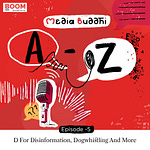One paragraph each to share, from three books that I’ve reading. What’s not to like about that, I thought. And so I decided to plunge headlong into the world of Substack Video by reading out one paragraph — no more — from each of the three books.
I hope your mind feels quieter after watching or reading this.
The first paragraph is Learning from Silence: Lessons from More Than 100 Retreats by Pico Iyer.
“A monk is at heart the ultimate man of the world. That’s where his sense of kindness and self-sacrifice is most needed, and it’s to those in trouble that he must attend. He may deepen his commitment in private, but it’s the streets that he has to reap the blessings of his practice.”
I chose this paragraph because there is a temptation to believe that a monk is someone who withdraws from society, and I was reminded by Iyer that this is not true at all.
The second paragraph is from In a Flight of Starlings: The Wonder of Complex Systems by Giorgio Parisi. He is a Nobel Prize winner in physics but he writes in very clear prose.
“This…is the scientist’s calling: to imagine or to do what no one has done before. But we cannot spend our lives attempting to open locked doors that no one has a key to. Before beginning, it is crucial to understand whether or not we have the competence, technical skill, and tools that will allow us to accomplish the job. Even then, nobody has any guarantee of success.”
Parisi is the best of the best, and yet here he is, asking us to be careful before taking moonshots. He finishes the paragraph with this line, “We to have throw ourselves headlong into the task and aim high. Still, if the target is so high we have no chance of reaching it, then it’s better not to begin.”
The third paragraph I want to share is from What Ten Young Men Did, a coming-of-age novel. It’s a translation of a Sanskrit classic from the 7th century C.E. called the Dasakumaracharita by Dandin.
The thought I’m sharing from this book actually comes from a small introduction to Sanskrit in the beginning of the book. Isabelle Onians, the translator, writes that Sanskrit literature is full of puns or wordplay. Here’s more from her:
“Classic Sanskrit literature can abound in puns (slesha). Such paronomasia, or wordplay, is raised to a high art; rarely is it a cliche. Multiple meanings merge into a single word or phrase. Most common are pairs of meanings, but as many as ten separate meanings are attested.”
I first saw this book at the wonderful Albert Bender Room at the Green Library at Stanford University. Among all the Latin and Greek classics, there was an entire shelf of the Clay Sanskrit Library translations, and I chose this book to read.
I sat in a deep and comfortable armchair and read for about 10 minutes. It actually put me to sleep. When I awakened some 15 minutes later, I replaced the book in the shelf and went home. But the charm of Dandin’s masterpiece stayed with me, and I bought a personal copy.
That was in 2019. Since then, I’ve been reading a little here and there. It has proved to be utterly charming. And I don’t feel the need to sleep after reading a few pages.
Let me round thing off with an example of the wordplay. The wordplay or pun is in italics both from the original Sanskrit and the English translation:
Yuktam Kadambarim srutva kavayo maunam asritäh
Bana/dhvanav anadhyayo bhavatiti smrtir yatah.
Here’s the translation:
It is right that poets should fall silent upon hearing the Kádambari,
for the sacred law rules that recitation must be suspended when the sound of an arrow/the poetry of Bana is heard.- from Soméshvaradeva’s Moonlight of Glory
Speakers of many Indian languages will recognise the words ‘bana’ (arrow) and the root word ‘dhvani’ (sound).
Happy reading!












Share this post